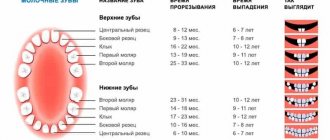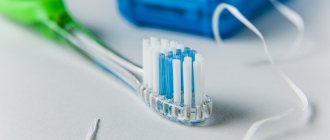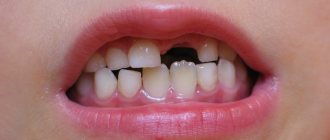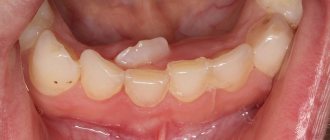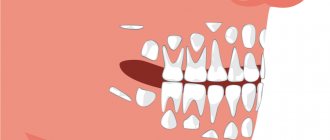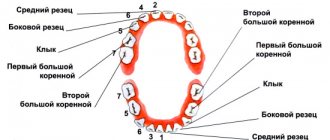Changing children's baby teeth to permanent ones is always an exciting time for parents. This process is quite lengthy and often painful for the child, because it can be accompanied by various inflammations and discomfort. To help parents, for a better understanding of the physiological processes associated with the formation of teeth, dentists offer to look at the pattern of loss of baby teeth in children.
Symptoms that indicate that the process has begun:
- Some children experience an increase in temperature (up to 38). In this case, you should not hesitate; it is better to seek advice from your doctor.
- Unpleasant sensations in the gums.
- The space between the teeth increases.
- The roots begin to dissolve (The roots of baby teeth are much shorter than those of permanent teeth. When the process reaches the neck, a tooth change occurs).
- Gums are bleeding.
Anatomical differences between primary and permanent teeth
As we said above, temporary teeth differ from permanent teeth in a smaller number, as well as in significantly smaller sizes (they are 2 times smaller than permanent teeth).
At the same time, the shape of the crowns of primary teeth is always more spherical, and in the area of the neck of the primary tooth there will always be a noticeably more pronounced narrowing. In addition, temporary teeth are whiter than permanent teeth and often have a bluish tint. Differences between temporary and permanent teeth (description below) –
Anatomical differences:
- Tooth enamel – the enamel of temporary teeth is much less mineralized (saturated with minerals, primarily calcium and phosphates). Therefore, with insufficient oral hygiene, children develop caries almost instantly. In addition, the thickness of the enamel of temporary teeth is approximately 2 times less than that of permanent teeth - this circumstance leads to a very rapid transition of caries to pulpitis. There are also many microcracks and pores on the surface of the enamel of temporary teeth.
- Dentin of the tooth - the dentin layer is located under the layer of tooth enamel, and its thickness is also 2 times less (than that of permanent teeth). The dentin of temporary teeth is lighter, it is less mineralized, softer, and therefore it is much easier to prepare with a drill than the dentin of permanent teeth. Due to the fact that dentin is less mineralized and softer, the carious process in dentin spreads deeper faster, which leads to the rapid development of pulpitis in baby teeth.
- Pulp (neurovascular bundle) - some parents ask: “Are there nerves in baby teeth?” Of course, they exist, but due to the thinner layers of enamel and dentin, the pulp in baby teeth is located much closer to the surface of the tooth. The pulp chamber (tooth cavity), in which the pulp is located, is always larger in primary teeth, and therefore the pulp occupies a relatively large volume in the tooth. And besides, in baby teeth the “pulp horns” (processes) are more pronounced, which creates an additional danger of injury to the pulp during the treatment of caries.
- Roots of teeth – some parents ask: “Do baby teeth have roots?” Of course, they have roots, but they are thinner and widely spaced (at the same time, the root canals and apical openings in baby teeth are wider than in permanent teeth). But the development and growth of the rudiments of permanent teeth leads to the formation of constant pressure on the roots of primary teeth, which leads to their gradual resorption and loss. We hope that our article: Scheme of loss of baby teeth in children was useful to you!
Sources:
1. Dental education of the author of the article, 2. Based on personal experience as a dentist, 3. The European Academy of Paediatric Dentistry (EU), 4. National Library of Medicine (USA), 5. “Pediatric therapeutic dentistry. National leadership" (Leontyev).
Everything has its time
One of the most frequently asked questions to our doctors from mothers is: “In what order do teeth begin to fall out?”
It usually starts at the age of 5 years. The very first teeth that undergo this process are the incisors, then the fourth and fifth teeth of the row, then the canines. To make it more clear to you, here is a diagram of the loss and eruption of baby teeth:
Don't worry if your child is over 5 years old and his teeth aren't starting to change. Each child’s body is individual, and much depends on nutrition, dental care, daily routine, and climatic conditions. In girls, the loss of baby teeth begins a little earlier than in boys. If you are still worried, then contact your dentist and conduct an unscheduled examination.
I would also like to note the timing. Complete replacement of milk teeth with molars occurs within 6-7 years. There is no need to specifically tear them out or loosen them. Everything will happen naturally.
The doctor prescribes removal only if the baby tooth has not yet fallen out, but the root tooth is already beginning to grow.
The structure of the dentition
The total number of primary teeth is 20, each jaw has 4 incisors (the central part of the upper and lower rows), as well as 4 molars (“chewing” 4th and 5th units). Adults normally have between 28 and 32 dental units. So, on the upper and lower jaws there is a symmetrical location:
- 4 incisors each;
- 2 fangs;
- 4 premolars;
- 6–8 molars.
Until what age do wisdom teeth grow? You may never wait for the “birth” of the notorious “eights” - congenital adentia of the third molars is considered the norm. Another clinical picture may develop: the wisdom tooth is “embedded” in the jaw, but does not erupt due to a lack of space in the dentition. If “eights” are still born, then this usually happens until they reach a maximum of 25 years of age.
No Ads
Features of baby teeth
Now I will answer another very popular question: “how do baby teeth differ from molars?”
These are the baby's very first teeth. They appear before the age of three, and begin to erupt until there are 20 teeth. See the photo above for the cutting diagram.
They do not have such deep roots as permanent teeth, have a more rounded shape and smaller size, and are white in color, while permanent teeth have a yellowish tint. By location, they are directed vertically, and the radicals are slightly outward.
Wisdom teeth cannot be milk teeth, because they grow into deep roots only by the age of 18-20, and sometimes later.
General principles of growth
Baby teeth begin to grow from 6-8 months of age. As a rule, by the first anniversary of his life, the baby has already “acquired” four upper and lower units. By the age of 2 years, the first canines and molars “come into the world”; after another six months, the second molars are added. The final appearance of the primary dentition (20 units) can be observed in three-year-old children.
As a rule, by the end of the first year of life, the baby “acquires” 4 anterior milk units
What to do if by 9 months the baby has not yet acquired a single tooth:
- carefully examine the oral cavity; the gums, as a rule, look slightly swollen and reddened; upon palpation, the tooth edge can be felt;
- in order to speed up the process of “birth” of the first units, pediatric dentists recommend that young parents purchase growth stimulants for baby teeth at the pharmacy - rubber ring toys;
- A light massage of the gums with a clean finger or a cold tablespoon will also only benefit the baby.
Important! Delayed growth of primary teeth can be either a variant of the physiological norm (for example, in boys this process usually begins later than in girls) or a symptom of various pathologies associated with growth retardation (in particular, rickets).
No ads 2
In the latter case, parents should seek help from a pediatrician - perhaps he will prescribe vitamins or calcium supplements to the child to normalize “healthy” mineral metabolism and improve metabolism in general. In rare cases, the absence of signs of teething up to a year indicates edentia (the rudiments of the milk units have simply not formed). In such a situation, the help of a pediatric dentist is required - he will send the child for an x-ray, based on the resulting image, he will make a diagnosis and select treatment.
Starting from the age of 5, baby teeth are gradually replaced by permanent units
To what age do a person’s teeth grow: throughout life, 20 units are replaced at a time (deciduous – permanent), and 8–12 units initially grow as molars. General cutting scheme:
- medial lower incisors – 6–9 months;
- medial upper incisors – 7–10 months;
- lateral upper and lower incisors – 9–12 months;
- first upper permanent teeth – 12–18 months;
- first lower molars – 13–19 months;
- upper (16–20 months) and lower (17–22 months) canines;
- second lower (20–33 months) and upper (24–36 months) root units.
These figures are very relative; it all depends on the individual characteristics of a particular organism. As a rule, by the age of 3, a child has already grown all his milk teeth, and from the age of 5 they begin to gradually be replaced by molars. Why teething may be disrupted: type of feeding (instead of breastfeeding - artificial), genetic factors, loss of baby teeth due to dental problems.
Daily doctor's advice on caring for baby teeth:
- Start brushing your baby's teeth only after they have erupted; use a special brush for babies.
- When your child turns one year old, buy a brush with soft bristles and toothpaste without fluoride; it will not harm the child if he swallows it.
- Brush your baby's teeth 2 times a day (morning and evening)
- Don't put off going to the dentist. They should be regular, even if there are no signs of concern.
- Include more fresh greens, fruits and vegetables in your diet.
How do “eights” erupt?
It is impossible to give an unambiguous answer to the question of when wisdom teeth begin to grow and until what age do they grow. Third molars “come into the world” in the period from several months to 2-3 years, causing a lot of unpleasant sensations. When the “eights” begin to grow is influenced by many factors - in particular, the number of bone buds, heredity, and the anatomical features of the jaw (its shape). Due to the fact that third molars often create a certain discomfort - they affect the functioning of the TMJ, provoke sinusitis, and “displace” neighboring units of the dentition - they are often removed.
The main indications for extraction are:
- persistent hyperthermia (2–3 days) during the growth of wisdom teeth;
- acute inflammation of the gums (gingivitis) at the site of eruption;
- severe pain that makes eating difficult.
Anatomical features (shape) of the jaw, heredity and a number of other factors determine the timing of teething
Doctor's advice when the process of changing teeth begins:
- After tooth loss, let your baby not eat for 3 hours, and you should also not drink very cold or hot drinks.
- Protect your child from sour, spicy and very sweet, astringent foods. All this has a negative impact on teeth.
- If your baby is bothered by discomfort or pain after a baby tooth falls out, then buy a special gel, but it is better to choose it on the recommendation of a dentist.
- Do not let your child touch the hole where a tooth has fallen out, as it may become infected.
- To soothe your mouth, make a decoction of chamomile.
How to relieve your baby's condition
Many young parents are wondering how to relieve the unpleasant symptoms that accompany the “birth” of milk units. The simplest measure is to apply cold (a piece of ice) to the “working” gum. Dental gels or ointments can also come to the rescue, relieving pain, swelling, and stopping the inflammatory process. Important: any medications should be used only with the permission of a pediatrician (pediatric dentist).
Thus, pharmacies sell special gels with lidocaine and inert fillers (menthol, astringents, flavorings) intended for use exclusively during teething. Examples of such tools:
- Kalgel (contraindicated for diathesis).
- Dentinox.
- Kamistad.
- Holisal.
- Mundizal.
General recommendations for use: a small amount of the local drug should be applied to the “working gums” 3-4 times a day for no longer than 3 days in a row.
Read also
What to do if your tooth aches
Sometimes aching pain in a tooth can appear for no apparent reason at first glance.
Why do teeth crumble?
Tooth decay in general, and crumbling in particular, is not an aesthetic problem.
The structure of human teeth
Teeth are not only intended for mechanical processing of food, but are also necessary for the formation of speech, breathing, and influence facial features. To navigate what dentists advise, how to take care of your teeth, and what the risks of disease are, it is useful to know how they work.
Anatomical structure
3 parts that make up a tooth:
- Crown. The visible part of the tooth used for chewing. The outside is covered with durable enamel, which protects it from bacteria, chemicals contained in food, water, and saliva. The surfaces have their own names: Facial (vestibular) - in contact with the lip or cheek.
- Lingual (lingual) – the opposite of the facial, involved in the formation of speech.
- Occlusion – the upper surface in contact with the tooth of the opposing jaw.
- Contact (approximal) – contacts with adjacent teeth.
Milk teeth, having a largely similar structure, also have differences in anatomy:
- They are noticeably smaller in height than permanent ones.
- The crown is much wider than the root.
- Enamel is thinner and more fragile.
- The roots are more round.
- The wear of baby teeth, as well as their spontaneous loss, is a normal physiological process.
Histological structure
The structure has several layers:
- Enamel is the most durable fabric. When a tooth just erupts, a cuticle is located on it, which is gradually, under the influence of saliva, replaced by a pellicle.
- Dentin is a highly mineralized tissue that resembles bone, but has better mechanical strength. Instead of enamel, the root part of the dentin is covered with cement.
- The pulp, the central part of the tooth, is a soft connective tissue containing a large number of blood vessels. Caries and inflammatory processes “owe” pain to the pulp with its large number of nerve endings.
Milk teeth are distinguished by dentin with a lesser degree of mineralization, which weakens their protection against caries. The volume of pulp occupies most of the tooth, and small protective layers (enamel and dentin) provide less protection against the penetration of bacteria and the development of inflammatory processes.
Types of teeth
There are 4 groups:
- Incisors. 4 chisel-shaped cutters. The largest are a pair of upper central incisors, and the situation is opposite from below - the lateral incisors are slightly larger than the central ones.
- Fangs. 2 on the upper and the same number on the lower jaw. Their length is longer than the others, the front wall is convex.
- Premolars. There are 8 in total, prismatic in shape, the upper surface with two tubercles (buccal and lingual). Premolars have 2 roots. The second premolar has a larger buccal surface. There are no primary premolars.
- Molars. The first molar (molar) is the largest tooth in the upper jaw. The chewing surface has four tubercles, 3 roots. The cubic-shaped second molar is smaller, and the buccal tubercles are larger than the lingual ones. The third (“wisdom tooth”) is in many ways similar to the second, but not everyone has it.
How does teeth change?
The rudiments of future permanent units are located under the root of the baby tooth and are separated from it by a thin bone septum. At 6–7 years of age, osteoclasts of the connective tissue surrounding the baby tooth dissolve the mineral component of the septum and destroy it. At the same time, the pulp of the temporary unit is gradually transformed into granulation connective tissue rich in osteoclasts, which gradually destroy the dentin of the primary tooth. At the same time, the roots of the temporary units dissolve and, in fact, only the crown of the baby tooth remains. It can be easily removed on its own, with the help of the dentist’s manipulations, or it can be pushed out by an actively growing molar (permanent) tooth.
Anatomy of permanent teeth The permanent units of a child (and an adult) have a complex anatomy.
Visually, the tooth consists of three parts - crown, neck, roots.
- The crown is the visible part of the tooth that rises above the gum.
- The neck is the part of the tooth at the gum level, in the place where the crown meets the root, and the enamel of the unit turns into cement.
- The root is the part of the unit invisible to the eye, located in the alveolar socket. The base of each unit is made of dentin, a hard tissue. In the coronal part, dentin is covered with enamel, and in the root part there is cement. Inside the dentin is the dental pulp - loose fibrous soft connective tissue, penetrated by a large number of blood and lymphatic vessels and nerve endings. Passing along the root canal, through the apical foramen located on the upper part of the root, they communicate with the main neurovascular bundle, providing nutrition to the tooth, drainage of excess fluid and its innervation.
Normally, by the age of 13, when a permanent bite is formed, a child has 28 permanent teeth. At the age of 17 - 25 years, third molars (wisdom teeth) erupt and the number of units may increase - 32 teeth.
Why are the first teeth called baby teeth?
There are several opinions on this matter. Doctors attribute the authorship of the term to Hippocrates, who believed that these teeth are formed from mother's milk. Philologist N.N. Vashkevich states that “the term is a tracing from the Latin lactose “milk”. But the tracing paper is false, it is a misunderstood Arabic liwaqt - “for a while,” “temporary.”
One way or another, the first teeth actually actively “feed” on breast milk, since it is from it that the child absorbs the main building material of teeth and bones – calcium. And although baby teeth erupt, as a rule, at 6-7 months, their formation in the child’s jaws occurs long before that.
It is worth noting that for the health and strength of the first teeth, it is mother’s milk (not cow’s) that is necessary, since the nutrients from it are maximally absorbed by the baby’s body. Therefore, the universal recipe “breastfeed your baby” will help in this matter.
Why can a lot of time pass between the loss of baby teeth and the eruption of permanent teeth?
Most often, the front teeth grow quickly. And canines and baby molars (premolars) can be delayed. After a temporary tooth falls out, it may even take 4-6 months until a permanent tooth erupts in that place. Just expect it and take good oral care. But if this period begins to exceed six months, so as not to worry, it is better to visit a doctor. After examining the child, he will be able to decide whether the permanent tooth needs to be stimulated to grow.
Milk teeth in adults: when childhood drags on
Yes, this happens, but very rarely. In dentistry, there are cases where baby teeth were found in thirty-year-old and even fifty-year-old people: doctors call such teeth persistent. What is the reason for such dental infantilism? This happens precisely for the reason that we talked about above. When a person lacks the rudiments of permanent teeth, the replacement mechanism does not start. Simply put, nothing puts pressure on the roots of baby teeth, which is why they do not dissolve, but remain in the oral cavity of an adult. It also happens that the rudiments of the molars are located too deep and also do not come into contact with the roots of the milk teeth. Treatment here is purely individual. If a person has a healthy baby tooth with intact roots, under which there is no molar rudiment, it makes sense to have it replaced with a veneer or crown in order to protect it from the external environment and give it the desired shape. If the baby tooth is unstable and its roots are resorbed, extraction is recommended. If there is a permanent tooth germ underneath, then it is “pulled” out; if not, a prosthesis is installed.
What parents should pay attention to
The body prepares for the eruption of milk teeth in infants in advance. Therefore, the first signs are quite easy for mothers and fathers to identify on their own, as the child’s emotional state changes, he is capricious, sleeps poorly, and puts toys in his mouth. In addition, the baby has:
- excessive salivation
- swelling and redness of the gums, accompanied by itching
- increase in body temperature
- loss of appetite
All these symptoms usually disappear after the tooth erupts.
What to do when teething?
The first teeth erupting will cause discomfort in the child, and this is a natural process. During this period, salivation increases, and a runny nose may occur due to the eruption of the upper teeth. The normal pace is for new teeth to appear every few weeks.
Be prepared for the fact that the child will be capricious and refuse to eat, and his temperature may rise. To make this period easier, you can use special teething toys. During this period, the gums become inflamed and cause discomfort - they can itch and hurt. Talk to your dentist: There are safe cooling gels for children that can help reduce the intensity of teething and teething symptoms in children.
It is also recommended to replace drinks with plain water. Juices and other drinks that contain sugar create an acidic environment in the mouth. Because of this, an inflammatory process may begin. Care should be taken to disinfect pacifiers and toys that children may put in their mouths.
The first teeth appear at the age of six months. The first chewing teeth appear between the ages of 1 and 1.5 years. Fangs are cut between the ages of 2 and 2. After this, by the age of 3, the following chewing teeth appear. Each new group requires attention. Thus, it is important to brush your chewing teeth well after eating, since the enamel of baby teeth is quite weak. Retention of food on the surface can easily cause inflammation.
It is also important to ensure that the child weans the habit of the pacifier and stops putting his fingers in his mouth. If this does not happen, an incorrect bite will be formed.
Drop order
The dropout pattern looks like this:
- 5-7 years - central incisors;
- 7-8 - lateral incisors;
- 9-11 - first molars of the upper jaw and second molars of the lower jaw;
- 9-12 - fangs;
- 10-13 - second molars of the upper dentition and first lower ones.
The diagram shows that the timing of changing units is quite arbitrary and quite long. This is why some children already have a permanent bite at the age of ten, while others still walk around at the age of 12 with actively loose baby teeth.
Answers to frequently asked questions about x-rays of baby teeth in children
We offer expert answers from specialists from the Smile Factor network of clinics to frequently asked questions by parents.
Can an x-ray be prescribed to a child “just in case”?
Unfounded medical (and dental) research is prohibited by SanPiN.
But, most often, diagnosis according to indications is at the discretion of the attending physician. Any parent can ask clarifying questions and learn more about the assigned test and what it is for. What is better - 2D or 3D scanning result?
It all depends on the goals of the diagnosis.
In some cases, a 2D image is sufficient, while in others a CBCT scan is required to obtain a 3D image. Taking into account how CT scans of the jaw and teeth are done, the procedure is not much different from a simple x-ray in terms of safety and is indicated for obtaining more extensive data about the child’s dental system in the images. Are x-rays harmful to a child?
Modern X-ray machines (and most often these are ultra-modern tomographs) produce the minimum possible radiation dose during operation, which does not cause any harm to the child’s body. To achieve the maximum recommended radiation exposure of 1000 µSv per year, a child needs to undergo about 400 x-ray examinations. It becomes clear that so much research is simply not needed. And the radiation that a baby receives during a CT scan is equal to what he receives after a week of watching TV.
At what age should a bite be corrected?
You can start correcting your bite at 4-5 years of age. In this case, the growth of permanent teeth will be even, in the place intended by nature. Therefore, there is no need to carry out subsequent long-term bite correction. In any case, if there is a malocclusion, the problem can be eliminated efficiently and as quickly as possible by contacting a qualified orthodontist as early as possible.
| Teeth | Dairy (temporary) | Permanent | ||
| Jaw | Lower | Upper | Lower | Upper |
| Central incisors | 6-12 months | 8-12 months | 6-7 years | 6-8 years |
| Lateral incisors | 10-16 months | 9-13 months | 7-8 years | 7-8 years |
| Fangs | 17-23 months | 16-22 months | 9-10 years | 11-12 years old |
| First Premolars | — | — | 10-12 years | 10-11 years |
| Second Premolars | — | — | 11-12 years old | 10-12 years |
| First Molars | 14-18 months | 13-19 months | 6-7 years | 6-7 years |
| Second Molars | 23-33 months | 25-33 months | 11-12 years old | 11-13 years old |
